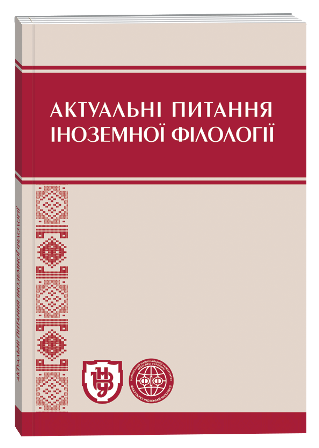FRAME STRUCTURES DENOTING INNER STATE OF LITERARY CHARACTERS IN THE GERMAN FICTION DISCOURSE
Keywords:
frame, frame structure, terminal, terminal element, inner stateAbstract
The article deals with the depiction of the inner state of the literary figures by means of the frame structures on the material of the German fiction discourse represented by Friedrich Griese’s novel “Das nie vergessene Gesicht”. In a discourse the emotional state can be rendered with the help of different expressive means and methods. Frame structures denoting inner state of the personages are an important mechanism of the portrayal of the feeling sphere in a literary discourse. In the article the lexical units representing the terminals of the frame “Inner state” (“Innerer Zustand”) have been analyzed, its role in depicting of the character peculiarities of the literary heroes as well as in revealing of their inner world have been identified. The frame “Inner state” is considered to be a cognitive structure based on the categorical knowledge of psycho-emotional state of a person. On the ground of the dictionary definitions the terminals of the frame “Inner state” have been defined: ‘Quality’ (‘Eigenschaft’); ‘Feature’ (‘Zug’); ‘Health’ (‘Befinden’); ‘Mood’ (‘Verfassung’); ‘Psychical activity’ (‘Psychische Tätigkeit’); ‘Mode of existence’ (‘Die Art und Weise des Vorhandenseins’); ‘Property’ (‘Beschaffenheit’); ‘Spiritual-mental sphere’ (‘Geistig-seelischer Bereich’). On the basis of the analysis of the terminal elements denoting people’s feelings and emotions in the novel “Das nie vergessene Gesicht” the cognitive-pragmatic peculiarities of the frame structures which represent the frame “Inner state” in literary discourse have been researched. The results of the analysis have shown that the lexical units which represent the terminals of the frame “Inner state” play an important part in depicting of emotions and feelings of the personages in a literary discourse thus helping the author in the realization of his intentions concerning the portrayal of the many-sidedness of people’s inner world and imparting particular intensity and expressiveness to the description of the characters in a fiction discourse. The inferences of a reader also play an essential role because they are an effective means in the decoding of the author intentions.
References
Busel, V. 2003. Velykyi tlumachnyi slovnyk suchasnoi ukrayinskoi movy. Kyiv, Irpin: Perun.
Kozak, S. 2018. “Rol freimovykh struktur na poznachennia zovnishnosti u vidtvorenni kharakteriv ta pochuttiv literaturnykh geroiv (na materiali nimetskomovnoho hudozhnioho dyskursu)”. Aktualni pytannia inozemnoi filolohii 8:160–164.
Kubriakova, E. 1997. Chasti rechi s kognitivnoi tochki zreniia. Moskva: RAN.
Ortony, A., Clour, G., Collins, A. 1996. “Kognitivnaia struktura emotsii”. Yazyk i intellekt. Translated from English. Moskva: Progress. 314–384.
Psykhichnii stan. 2019. https://uk.wikipedia.org/wiki/Психічний_стан
Duden. 2001. Deutsches Universalwörterbuch. Mannheim; Leipzig; Wien; Zürich: Dudenverlag.
Fillmore, Ch. 1984. “Lexical Semantics and the Text Semantics”. Copeland, J. New Directions in Linguistics and Semiotics. Amsterdam. 123–147.
Griese, F. 1962. Das nie vergessene Gesicht. Göttingen: Sachse & Pohl.
Putnam, H. 1975. “Meaning of Meaning”. Gunderson, K. Language, Mind and Knowledge. Minnesota Studies in the Philosophy of Science. Vol. VII. 131–193.
Rickheit, M. 1990. Wortbedeutungen und lexikalische Repräsentationen. Osnabrück: Institut für wissensbasierte Systeme.
Schwarz, M. 1992. Kognitive Semantiktheorie und neuropsychologische Realität. Repräsentationale und prozedurale Aspekte der semantischen Kompetenz. Tübingen: Max Niemeyer Verlag.
Ukrainka. 2019. ukrainka.name/uk/Verses/DumyIMrii/JakDytynojuBuvalo.html].







